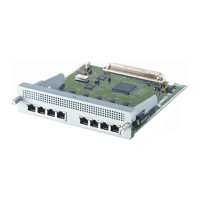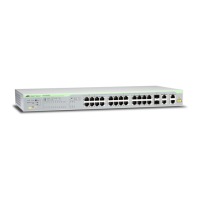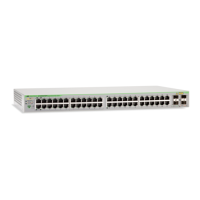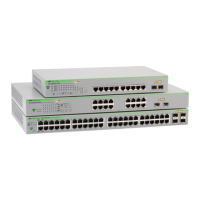Introduction Configuring BFD
Software Reference for SwitchBlade x3100 Series Switches (Network Management)
7-124
For the BFD link, parameters should be set as follows:
• INTERVAL -value of at least 200 ms (the value is negotiated to the greater value of the two sides of an inter-
face)
• DETECTMULTIPLIER - value of at least 5
(Together, this gives an interval of one second before a failure is declared.)
Using these values can help ensure that a link failure has actually occurred and so should be reported. More-
over, if the EPSR is carrying a large number of VLANS, the multiplier should be increased.
For the EPSR configuration, parameters should be set as follows:
• Health message (HELLOTIME) - 1 second (the default)
• Failure Interval (FAILOVERTIME) - 2 or 3 seconds (this value should always be at least twice the Health
message value)
• RingFlap (RINGFLAPTIME) - 5 seconds (0 is default)
Using these values can help ensure that the transition of EPSR from a normal to failed state, and from a failed to
a recovery state, is more controlled (less sensitive), and that BFD will be re-established on an EPSR ring that is
in a recovery state.
Caution: When enabling the BFD feature so that it can interact with a topology, you should first set the
multiplier with a large Detection Multiplier (such as 100) and then enable the service on both ends.
With an EPSR that uses many protection VLANs, this is especially important. After the protocol has
been established, you can set the Detection Multiplier to a smaller value. (You can do the reverse to
disable it without impacting service.)
7.7.5.4 Configuration Procedure
To enable BFD without disrupting service, you can first SET BFD (described below) with a relatively large
Detection Multiplier (such 255) and then enable the service on both ends. After the protocol has been estab-
lished, you can set the Detection Multiplier to a smaller value. You can do the reverse to disable it without
impacting service.
The following procedure shows the commands used to enable BFD.
TABLE 7-20 Configuration procedure for BFD
Step Command Description
Set the Detection Multiplier on both ends to a high value BFD
1
SET BFD INTERFACE=1.0, 2.0 DETECTION-
MULITPLIER=255
At the local end
2.
SET BFD INTERFACE=1.0, 2.0 DETECTION-
MULITPLIER=255
At the remote end
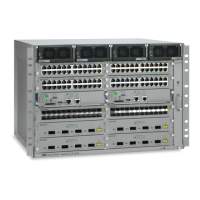
